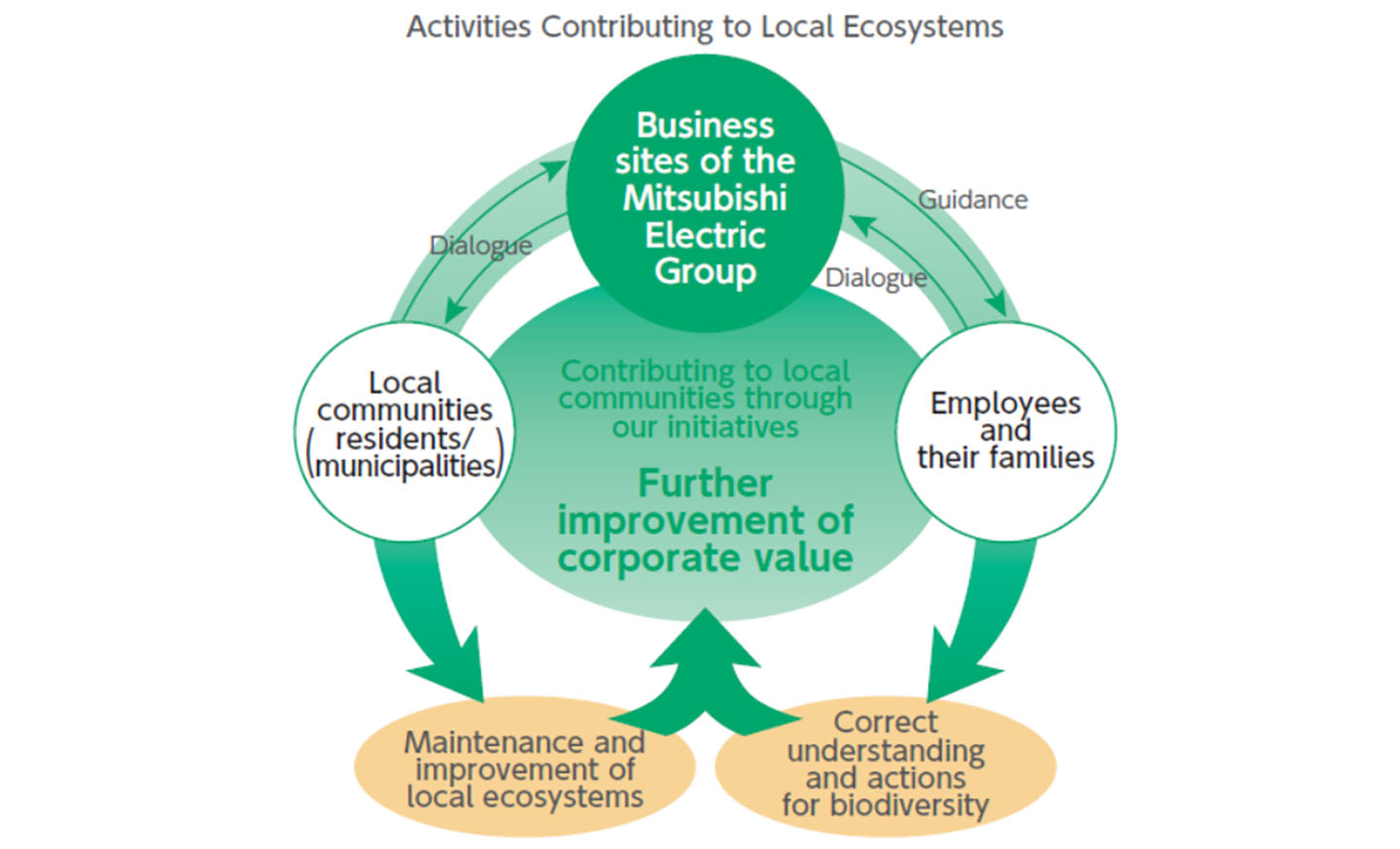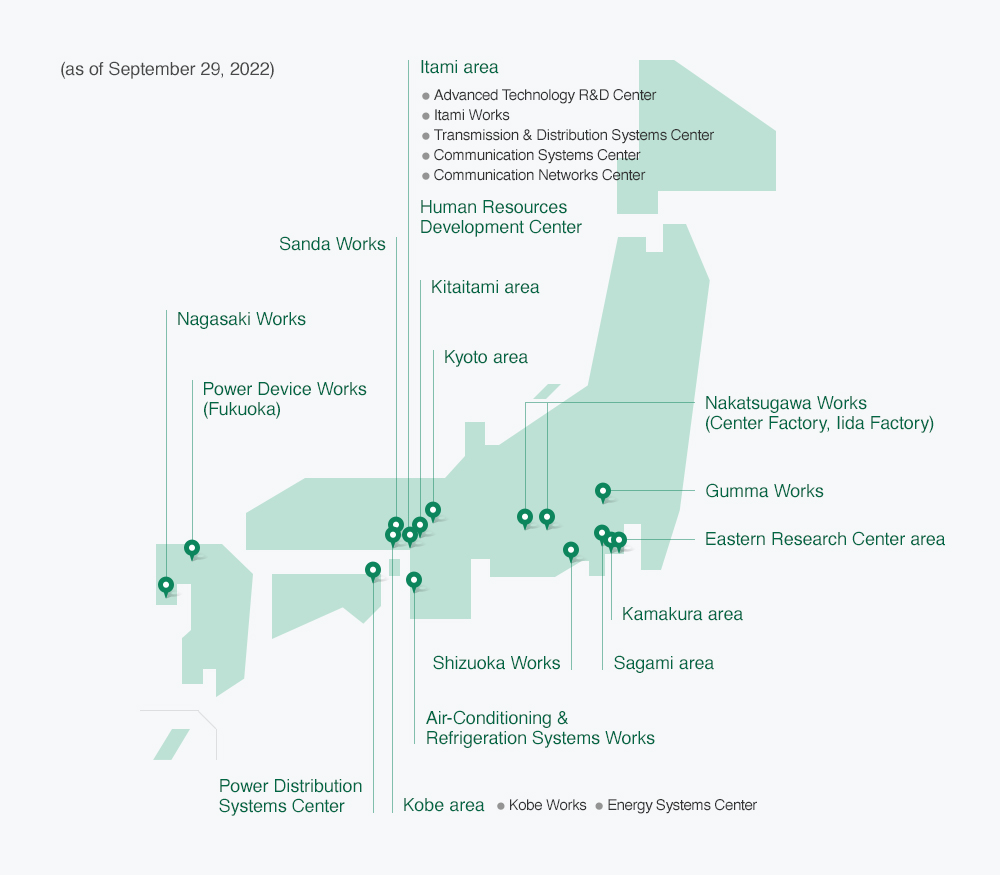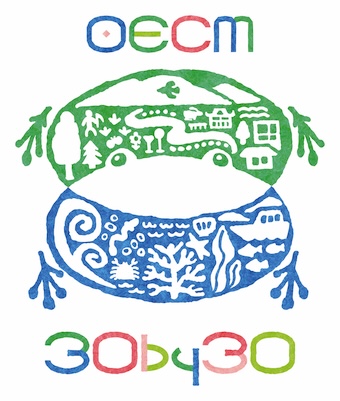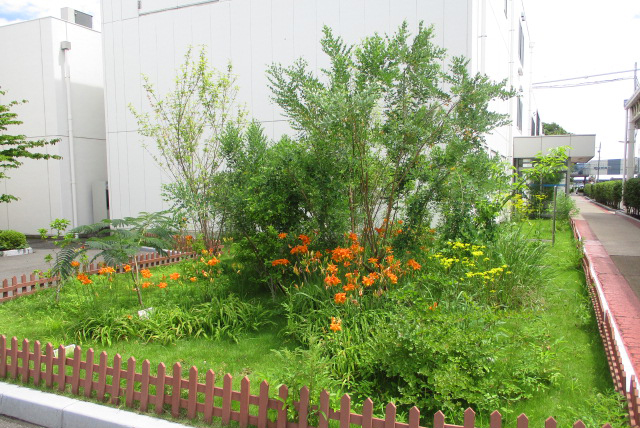Creating a society in tune with nature
Preserving Biodiversity at Business Sites
- Quantitative Assessment Based on the Biodiversity Guidelines (Check Sheet)
- Promoting Harmonious Coexisting in Nature at Our Business Sites by Initiating Studies on Living Creatures
- Initiatives toward Nationally Certified Sustainably Managed Natural Sites Certification
- Aiming for a Higher Level of Activities
- Improving the Quality of Greenery in Line with Three Courses of Action
Quantitative Assessment Based on the Biodiversity Guidelines (Check Sheet)
In March 2020, Mitsubishi Electric formulated the "Biodiversity Guidelines (Check Sheet)" to quantitatively assess the status of biodiversity initiatives at its business sites and steadily improve activities for preserving biodiversity. The guidelines promote the quantitative assessment of the implementation level of activities according to 186 promotional items divided into 5 mandatory items for all business sites and 7 areas (medium items) based on the above-mentioned "Courses of Actions." This check sheet is to be used by personnel in charge at each business site to self-assess the status of initiatives and identify strengths and issues at the implementation level.
5 mandatory items for all business sites
- A person in charge, the department in charge, and specific operations for promoting biodiversity initiatives have been identified.
- There is a medium-term plan for conducting biodiversity preservation activities.
- Biological surveys are conducted.
- Environmental education on biodiversity is provided every year.
- Feedback is given regarding the medium-term plan.
Assessment Results for Fiscal 2024

We defined the ratio of the score to the base year as the improvement rate* and evaluated the level of implementation of activities in each field in fiscal 2024. As a result, the company-wide average for each field is shown in the radar chart below, and the average improvement rate for all fields increased from 1.35 in fiscal 2023 Assessment Results for Fiscal 2024
Regarding the seven areas for which improvement rates are calculated in the Biodiversity Guidelines, the improvement rate increased in all areas this year, just like last year. In particular, the improvement rate for "7. Change the situation from everyone being disinterested and indifferent to everyone being involved" was 0.11 points, the highest increase rate ever. This rise suggests that the importance of biodiversity preservation activities has become more widely understood among employees. It also proves that this change in awareness can be attributed to each business site's educations and information disseminations to raise the profile of biodiversity preservation activities among employees.
Using the Biodiversity Guidelines, we will continue our efforts to vitalize and elevate our biodiversity preservation activities to an even higher level.
- * Improvement rate is calculated by dividing the score of the year being evaluated by the score of the base year, with fiscal 2020 as the base year.

Promoting Harmonious Coexisting in Nature at Our Business Sites by Initiating Studies on Living Creatures
Our lives are supported by Ecosystem Services* based on biodiversity, such as food and water supplies, climate stability, etc. In order to maintain this way of life, the Mitsubishi Electric Group established the Action Guidelines for Biodiversity in May 2010. As a measure to conserve biodiversity at our business sites, we have established three courses of activities at all our business sites: reducing negative impacts on living creatures; aiming for more fruitful symbiosis with other living creatures; and restoring the relationship between employees and nature while working. By promoting Improving the Quality of Greenery activities at each of our business sites, we are working to expedite employees' understanding of and participation in the activities, thereby contributing to the surrounding community and developing human resources who will act for the global community.
- * Ecosystem Services are generally classified into four categories: Provisioning Services, Regulating Services, Cultural Services, and Supporting Services (e.g., UN Millennium Ecosystem Assessment).
Mitsubishi Electric is contributing to the 30by30*1 international biodiversity protection goal by preserving green spaces at its factories to harmonize with local environments and provide habitats for various animal and plant species. The company expects to have a number of its properties recognized as Nationally Certified Sustainably Managed Natural Sites*2 by Japan’s Ministry of the Environment, which would achieve one of the goals outlined in Mitsubishi Electric’s Environmental Plan 2025.
- *1A target to effectively conserve at least 30% of land and sea as healthy ecosystems by 2030.
- *2Sites certified by the Ministry of the Environment where biodiversity protection is being promoted through private-sector initiatives.
Kamakura area
In the Kamakura area, we are committed to preserving rare species identified on our premises while also creating opportunities for employees to engage with nature and appreciate biodiversity.
Sagami area
In the Sagami area, we maintain and manage two types of green spaces: a biodiversity green space where wildlife is prioritized and a scenic green space that emphasizes visual appeal.

Shizuoka Works
At the Shizuoka Works, we are cultivating a stepping-stone green space that links nearby ecosystems and enhances habitat accessibility for wildlife.

Nakatsugawa Works
Since the Iida Factory of the Nakatsugawa Works was founded, we have been cultivating apple trees, which are deeply connected to the region, to build community ties.
Inazawa Building Systems Works
At Inazawa Building Systems Works, we are continuing our efforts to manage green space in ways that support biodiversity-especially on our factory rooftop.
Kobe area
In the Kobe area, we are working with local governments and educational institutions to conserve and cultivate locally native species.

Power Distribution Systems Center
The Power Distribution Systems Center has been working to protect wild birds and insects by maintaining a biotope sensitive to the surrounding environment.

Initiatives toward Nationally Certified Sustainably Managed Natural Sites Certification

To contribute to achieving the 30by30 target*1 through our biodiversity conservation activities at business sites, Mitsubishi Electric is advancing efforts to secure certification as a Nationally Certified Sustainably Managed Natural Site*2.
Nationally Certified Sustainably Managed Natural Sites
- Power Distribution Systems Center
- Shizuoka Works
- Sagami area
- Eastern Research Center area
- Kobe area
- *1 A global biodiversity target adopted under the Kunming-Montreal Global Biodiversity Framework, calling for the effective conservation of at least 30 percent of terrestrial and marine areas as healthy ecosystems by 2030.
- *2 A governmental certification system for areas where biodiversity is conserved through initiatives by companies, organizations, individuals, or local governments. Certified sites-excluding overlaps with designated protected areas such as national parks-are registered in the international OECM (Other Effective area-based Conservation Measures) database.
Nationally Certified Sustainably Managed Natural Sites (the Ministry of the Environment)
Aiming for a Higher Level of Activities
The Mitsubishi Electric Group has long promoted "Improving the Quality of Greenery" at all of its business sites. The aim is to encourage all employees to recognize biodiversity-related issues as personally relevant issues and to act proactively and voluntarily. In recent years, as our efforts have become more widespread, we have shifted toward creating a mechanism to continuously upgrade our activities.
Diverse benefits we receive from biodiversity are called Ecosystem Services and are categorized as follows:
- Provisioning Services, which provide food and resources;
- Regulating Services, which regulate the climate;
- Cultural Services, such as the healing effects of the natural landscape;
- Supporting Services, such as soil formation.
The preserving biodiversity is vital for the continued existence of human beings and is the essence of environmental issues.
Since it takes many years to maintain and improve biodiversity, steady and continuous efforts are required. Therefore, we will continue to promote biodiversity initiatives as part of our business activities, along with other issues such as achieving the Aichi Targets*1 and contributing to the SDGs*2.
Through these efforts, we hope to further contribute to the preservation of the local ecosystem and earn the trust and appreciation of local communities, which will lead to further boosting our corporate value.
- *1 Aichi Targets: Global targets adopted at the 10th Conference of the Parties (COP10) to the Convention on Biological Diversity held in October 2010.
- *2 SDGs: (Sustainable Development Goals)
Sustainable Development Goals through 2030, included in the 2030 Agenda for Sustainable Development, adopted by the UN General Assembly in September 2015.

Improving the Quality of Greenery in Line with Three Courses of Action
The Mitsubishi Electric Group has set forth three courses of action as guidelines for all business sites. They are: (1) reducing negative impact on living creatures, (2) aiming for a richer symbiosis with other living creatures, and (3) restoring the relationship between employees and nature in the working environment. At each business site, action plans provide for the preservation of local indigenous species, control of alien species, and development of green space in consideration of the surrounding ecosystem, to ensure these initiatives are steadily addressed in all businesses.
Three Courses of Action
| Courses of Action | Examples | |
|---|---|---|
| A. Reducing negative impact on living creatures | 1. Control development pressure and alien species pressure* | (1) Assessment of impacts on living creatures (2) Alien species control |
| 2. Call attention to and preserve rare species and endemic species | (1) Disclosure of list of living creatures on premises (2) Preservation of rare species and endemic species (3) Cooperation in regards to conse |
|
| 3. Manage pesticides, preserve greenery and natural resources | (1) Control the killing/harming of living creatures (2) Consideration to natural resources, such as water and soil |
|
| B. Aiming for more fruitful symbiosis with other living creatures | 4. Set up functional greenery | (1) System to manage green space (2) Management of land used by flying organisms (3) Development of priority land for greenery and living creatures (4) Provision of continuity of greenery with areas surrounding business sites (5) Contribution to biodiversity preservation activities in areas surrounding business sites |
| 5. Break away from agricultural orientations such as simplifying/specifying greenery | (1) Diversification/multi-stratification of vegetation (2) Management of greenery that accords with the characteristics of plants, etc. (3) Contribution/consideration to regions |
|
| C. Restoring the relationship between employees and nature in the working environment | 6. Proactively utilize ecosystem services in the workplace (break rooms, individual floors) | (1) Provision and utilization of opportunities for cultural services (2) Provision and utilization of opportunities for supply services |
| 7. Change situation from everyone being disinterested and unrelated to everyone being involved | (1) Education for understanding and promoting action (2) Creation of relationships through the workplace or work duties |
|
- * Activities are carried out pursuant to the regulation on raising, planting, storing, carrying, or other handling of specified IAS in the Invasive Alien Species Act.